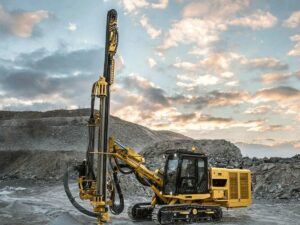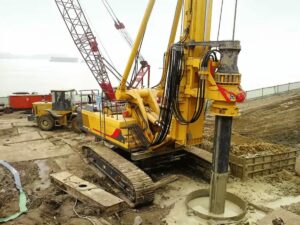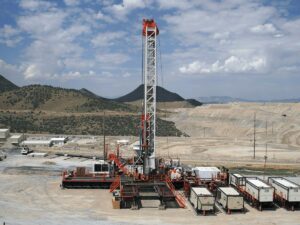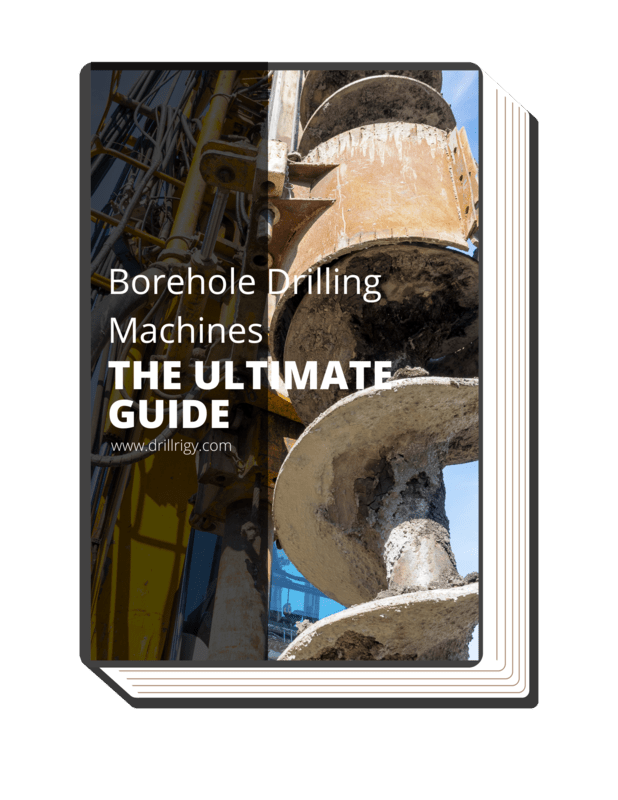Are you puzzled by the choice between DTH and Rotary Drilling methods for your operations? Understanding the distinctions can significantly affect your bottom line.
With years of expertise in the drilling industry, we offer insights that help business owners like you make informed decisions.
We’ll dissect the key differences between Down-the-Hole (DTH) and Rotary Drilling, focusing on efficiency, cost, and application scope, to guide you in choosing the most suitable drilling method for your business.
Unlock the strategic advantages of choosing the right drilling technique for your next project. Read on!
1. Brief Overview of Drilling Technologies
In the expansive world of drilling technologies, efficiency and accuracy are of paramount importance. According to CONNY LI, advanced drilling technologies minimize the footprint of drilling operations, making it crucial for businesses to stay abreast of the latest developments. Among these, two key methods stand out for their application versatility and robustness: Down-The-Hole (DTH) and Rotary Drilling.
DTH drilling focuses on delivering precise, high-impact drilling force directly into the rock. It is often preferred for deeper drilling applications where accuracy is a high priority. On the other hand, Rotary Drilling relies on rotational force and is typically chosen for shallow-to-medium depth boreholes.
Understanding the capabilities and limitations of each method is essential for optimizing operations. Being well-informed allows for more strategic decisions in project planning, ultimately contributing to better outcomes and reduced costs.
2. Understanding DTH (Down-The-Hole) Drilling
DTH (Down-The-Hole) Drilling is a drilling technique that employs a specialized hammer to generate high-impact force directly at the drill bit. This method is particularly effective for drilling deep, straight holes in hard-rock formations. To know more abouut this technique, here are in-depth details about DTH drilling making it versatile and efficient:

Mechanisms and Working Principles
Valve-less Air Distribution
This system offers increased reliability by minimizing the number of components susceptible to wear and tear. It simplifies the air distribution process, reducing maintenance downtime. This design aspect contributes to the drilling system’s overall longevity.
- Working Principle: In this design, air flows directly through the drill string, which eliminates the need for traditional valve systems and minimizes points of mechanical failure.
Rotary-percussive Drilling
This dual-action approach combines the rotation of the drill string with percussive impacts. It provides a balanced drilling solution that optimizes both penetration rates and hole straightness. It’s particularly well-suited for variable rock formations where a single drilling method may be insufficient.
- Working Principle: While the rotary action assists in the cutting and shearing of the rock, the percussive action fractures it, offering a more efficient drilling process.
Foam Drilling
This specialized method employs foam instead of traditional fluids to suspend and lift rock cuttings. It provides better control over the hole cleaning process, particularly in formations where water or air is less effective. Foam drilling is most effective in unstable or porous formations.
- Working Principle: The foam acts as a carrier medium, lifting rock fragments more effectively than water or air and reducing the risk of borehole wall collapse.
Air-core Drilling
This method is generally employed for softer ground conditions where maintaining sample integrity is crucial. It is faster and more cost-effective in these conditions compared to other drilling methods. It’s particularly useful for environmental or exploratory drilling where sample contamination must be avoided.
- Working Principle: Pressurized air is used to lift cuttings from the borehole, eliminating the need for drilling fluid and thereby maintaining sample integrity.
Common Applications and Industries
- Mining: DTH offers unparalleled accuracy and the ability to drill deep, straight holes which are crucial for successful mineral extraction. Drillrigy’s technology is constantly evolving to meet the industry’s stringent safety regulations. The speed and efficiency of DTH drilling also make it cost-effective over the lifespan of a mining project.
- Construction: DTH drilling serves a variety of purposes including foundation drilling, road construction, and anchoring. Its ability to precisely control hole diameter and depth is particularly beneficial for structural integrity. The mechanism’s durability and reliability also contribute to reduced project times, thereby saving costs.
- Oil and Gas: DTH drilling offers an effective alternative to traditional drilling methods, particularly in challenging conditions such as hard rock or extreme depths. Its high rate of penetration and accuracy make it a preferred choice for specialized applications within this industry.
- Water Well Drilling: DTH drilling technology allows a faster and deeper boreholes. It offers high accuracy, ensuring that the well accesses cleaner, uncontaminated water layers. The technology is also more efficient in terms of time and cost making it increasingly popular for well drilling projects.
- Geothermal Energy Production: DTH drilling offers the depth and precision needed to access geothermal reserves efficiently. It allows for more accurate placement of geothermal probes, ensuring effective heat exchange and, by extension, more efficient energy production.
Advantages and Disadvantages
Advantages:
- High drilling speed, especially in hard rock formations.
- Capability for deep drilling, often beyond 300 meters.
- Excellent accuracy and hole straightness.
- Simplified equipment maintenance due to fewer moving parts.
Disadvantages:
- Higher upfront equipment costs.
- Not suitable for all types of geological formations.
- May require more experienced personnel for operation.
3. Understanding Rotary Drilling
Rotary drilling is a technique that employs a rotating drill bit attached to a drill string. The method is used to bore holes in various types of surfaces, particularly in softer formations. The rotary motion aids in breaking up the subsurface material, making it easier to remove. Let’s explore the distinctions of this technique below:

Mechanisms and Working Principles
Drag Bit
The drag bit is generally used for softer formations like clay and shale. This bit doesn’t have rolling cones; instead, it uses static blades to scrape or cut the formation. Because it lacks moving parts, it usually experiences less wear and tear.
- Working Principle: As the bit rotates, its fixed blades scrape the formation, enabling progress in softer geological settings.
Diamond Bit
Utilizing industrial diamonds, this bit is made to withstand extremely hard formations. The diamonds act as cutting elements, grinding away the rock with high efficiency. This bit is often reserved for specialized applications due to its high cost.
- Working Principle: The diamond elements grind down rock formations, rather than chipping or crushing them, allowing for a clean, precise hole.
Steerable Systems
Advanced technology has made it possible to steer the drill bit during the drilling process. This is highly beneficial in directional drilling operations where the trajectory must be controlled. Drillrigy’s machine systems usually integrate a downhole motor and navigational sensors.
- Working Principle: Advanced sensors and controls adjust the bit’s orientation in real-time, enabling precise directional drilling while maintaining rotary action.
Hole Enlargement Tools
After drilling the initial hole, these tools are utilized to widen it to the desired diameter. They can be mechanically or hydraulically activated and are key in applications where large-diameter holes are required.
- Working Principle: Once deployed, these tools cut into the existing borehole wall, enlarging the diameter through rotary action and the assistance of drilling fluid.
Common Applications and Industries
- Oil and Gas: Rotary drilling serves as the backbone for oil and gas exploration. For instance, its compatibility with steerable systems also allows for advanced directional drilling. It enables drilling through various geological formations and offers cost-efficiency.
- Mining: In mining, rotary drilling is utilized for both exploration and the extraction of minerals. The method is ideal for drilling large-diameter holes, a common requirement for blasting applications. Its high speed and versatility make it highly desirable in mining operations.
- Water Well Drilling: Rotary drilling’s effectiveness lies in its capability to drill deep and straight wells quickly. With a variety of available bits, it can be tailored to match specific geological conditions. Its speed and precision make it a go-to choice for many water well drilling projects.
- Construction: Rotary drilling’s speed and precision are highly beneficial in construction timelines, which are often tight. The method also offers the flexibility of using different types of bits, making it adaptable to various ground conditions. The added possibility of using hole enlargement tools makes it even more versatile.
Advantages and Disadvantages
Advantages:
- High drilling speed allows for faster project completion.
- Versatility in application makes it suitable for various geological formations.
- Advanced systems offer directional drilling capabilities.
- Adaptability to different bit types provides flexibility in drilling operations.
Disadvantages:
- The cost can be high, especially in hard or abrasive formations.
- Complexity in setup requires skilled personnel.
- Environmental risks arise from the use of drilling fluids.
4. DTH vs Rotary: A Comparative Analysis
The borehole drilling industry relies on efficient and effective drilling methods. Drilling speed, cost-efficiency, depth capabilities, and geological adaptability are vital factors when choosing between DTH and Rotary drilling methods. Below is a comparative analysis structured around these key parameters:
Drilling Speed
The drilling speed is a crucial factor in borehole projects, affecting timelines and overall costs. It is a determinant of how fast a project can be completed.
- DTH: In hard rock formations, Down-the-Hole (DTH) drilling typically offers higher drilling speeds. The combination of hammer action with rotation enables rapid penetration. This efficiency is particularly noticeable in projects with tight deadlines or in situations where faster drilling can offset higher upfront costs.
- Rotary Drilling: Rotary drilling may offer slower speeds in hard rock conditions but is often more efficient in softer terrains. The method employs a simple rotation and drilling fluid circulation process, which is generally less complex and quicker to set up in non-hard rock scenarios.
Cost-Efficiency
Cost-efficiency is another significant consideration in choosing a drilling method, as it impacts the overall budget of a project.
- DTH: Down-the-Hole drilling usually requires a higher initial investment due to specialized hammers and drill bits. However, the long-term cost benefits can outweigh these initial expenditures, especially when time is a significant factor in a project.
- Rotary Drilling: It typically demands a lower initial investment and tends to offer lower operational costs in softer geological conditions. Furthermore, equipment wear and tear are usually less severe than in DTH drilling, contributing to long-term cost efficiency.
Depth Capabilities
The depth to which a drilling method can efficiently operate is essential for many projects, including those that aim for deep reservoirs.
- DTH: DTH drilling is effective up to around 1000 meters. Beyond this depth, the hammer action’s efficiency diminishes, making it less suitable for extremely deep drilling projects.
- Rotary Drilling: It excels in deeper operations, often effective at depths exceeding 2500 meters. This makes it an ideal choice for projects that require deep borehole drilling.
Geological Adaptability
The adaptability of a drilling method to various geological conditions can be a deciding factor in its suitability for a particular project.
- DTH: DTH drilling is specialized for hard rock formations and often faces challenges when the geological conditions are softer or mixed. The drilling speed and efficiency can significantly decline in these conditions.
- Rotary Drilling: It is versatile and adaptable to a wide range of geological conditions, including hard, mixed, and soft terrains. This adaptability makes it a more flexible choice for various project requirements.

5. 4 Factors to Consider When Choosing Between DTH and Rotary Drilling
Selecting the right drilling method can profoundly influence the efficiency, speed, and overall success of borehole drilling projects. Down-the-Hole (DTH) and Rotary drilling are the two primary methods used in the industry, each with its own set of advantages and limitations. Let’s explore these factors:
#1 Equipment Availability
Availability of specialized equipment could determine the viability of using a particular drilling method. For examplle, DTH drilling often requires high-pressure air compressors, which may not be as readily available as the mud pumps used in rotary drilling. Therefore, the ease of sourcing necessary equipment should be considered, especially for projects in remote locations or those operating on a tight schedule.
#2 Skill Level Required
The skill level of the drilling crew can be a determining factor. DTH drilling generally requires a more skilled labor force due to the complexities of handling high-pressure systems. Rotary drilling is often easier to master and may require less specialized training. Therefore, consider the skill sets available within your team or the need for additional training when choosing between these methods.
| Skill Level Consideration |
DTH Drilling |
Rotary Drilling |
| Operator Experience |
Moderate to High |
Moderate to High |
| Equipment Complexity |
Moderate |
High |
| Drilling Technique |
Requires specialized knowledge |
Requires specialized knowledge |
| Maintenance |
Moderate |
High |
| Safety Procedures |
Rigorous safety procedures |
Rigorous safety procedures |
| Geology Understanding |
Moderate to High |
High |
| Precision Drilling |
Good control over direction |
Suitable for deep drilling |
| Cost |
Moderate to High |
High |
| Environmental Impact |
Low |
Moderate to High |
| Project Scale |
Suitable for smaller projects |
Suitable for larger projects |
| Versatility |
Limited adaptability |
Versatile, various applications |
#3 Energy Efficiency
According to Matics, energy consumption can be a significant operating cost. Rotary drilling systems are often more energy-efficient as they usually require less air pressure and volume compared to DTH systems. This efficiency can result in lower fuel costs over the life of a project. Hence, it’s crucial to consider the energy efficiency of the drilling method when evaluating its long-term cost-effectiveness.
#4 Regulatory Compliance
Certain drilling methods may require special permits, especially in environmentally sensitive areas. Rotary drilling, for example, often involves the use of drilling fluids, which might be subject to environmental regulations. DTH drilling, although less reliant on such fluids, may have its own set of regulatory constraints. Thus, a thorough review of applicable laws and regulations is necessary when choosing a drilling method.
Dive Deeper Into Our Resources
Looking for more diverse product options? Browse through our handpicked selections:
Still haven’t found what you’re looking for? Don’t hesitate to contact us. We’re available around the clock to assist you.
Conclusion
This guide provides an in-depth comparative analysis of DTH and Rotary drilling methods, helping stakeholders make informed decisions based on drilling depth and operational complexity. Knowledge of these areas ensures that the drilling method chosen aligns well with project objectives.
For top-of-the-line drilling solutions that meet diverse project requirements, consider Drillrigy’s range of efficient and reliable equipment. Known for engineering excellence, they deliver performance you can trust. For more details or to discuss your specific needs, feel free to contact us.



